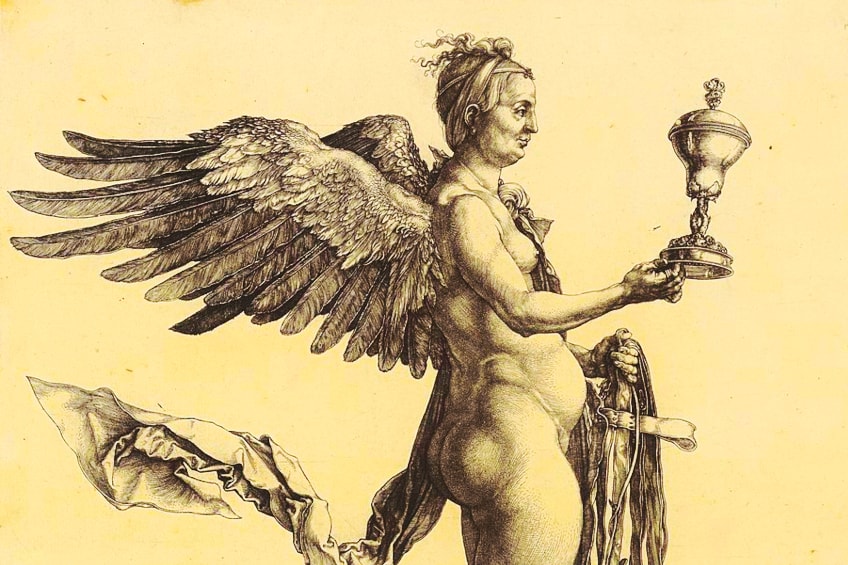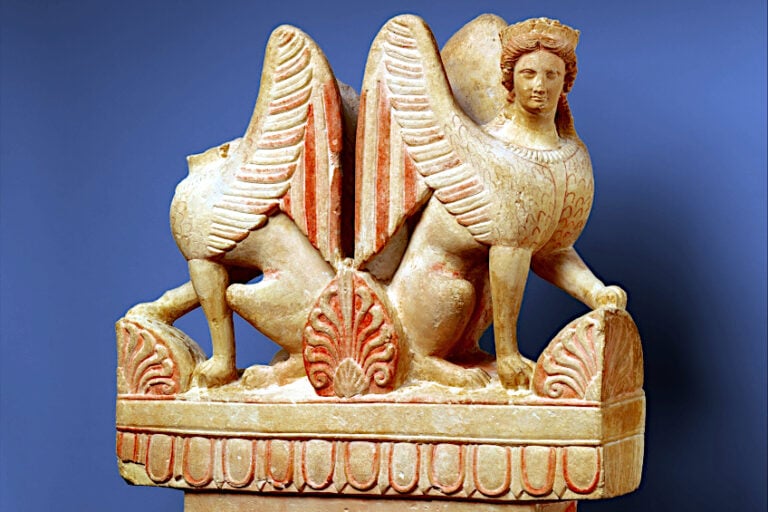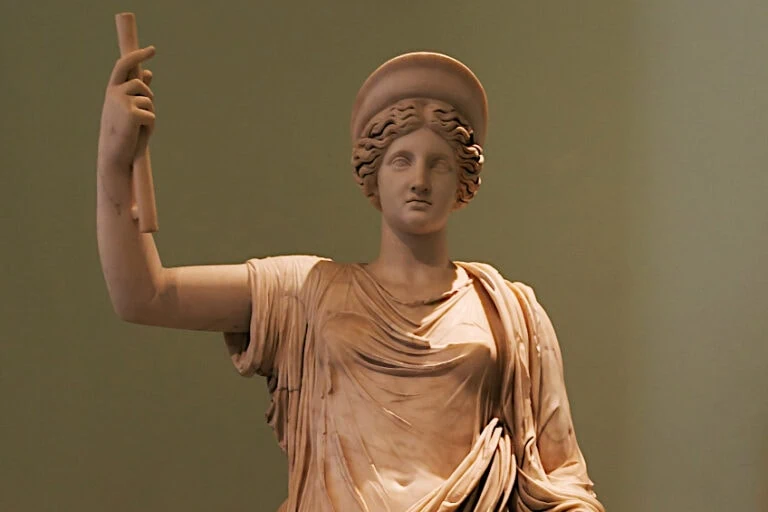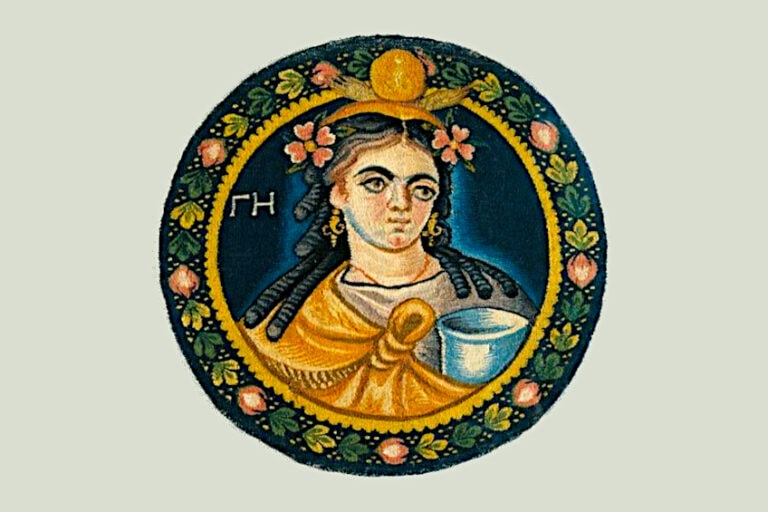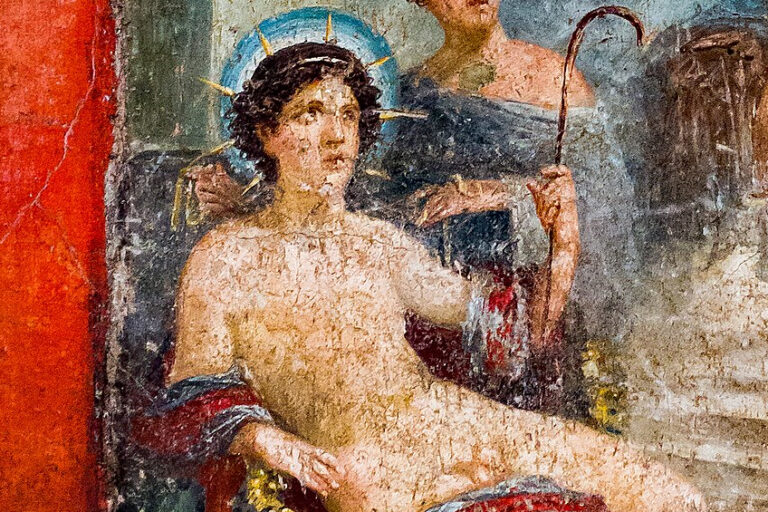Greek Goddess Nemesis – Divine Vengeance Personified
What is Nemesis the god of in Greek mythology? The Greek goddess Nemesis is considered to be the goddess of revenge and retribution by the ancient Greeks. She embodied the resentment fostered in men by those who committed crimes with seeming impunity or had gained fortune in an unethical manner. Join us below to learn more about the Greek goddess Nemesis.
Contents
The Significance of the Greek Goddess Nemesis
| Name | Nemesis |
| Gender | Female |
| Symbols | Swords, scales, daggers, and bridles |
| Personality | Indignant and vengeful |
| Domains | Retribution and revenge |
| Parents | Nyx or Oceanus |
| Spouse | Zeus and Tartarus |
| Children | Telkhines, Aktaios, Megalesios, Ormenos, and Lykos |
Nemesis supervised human activities in order to maintain balance. She measured happiness and misery, taking care that happiness was neither too frequent nor too extreme. If this occurred, Nemesis could trigger loss and misery. Nemesis was seen as a vengeful or punishing deity because she stopped Tyche’s (Fortune’s) lavish favors.
In Greek mythology, the Greek goddess Nemesis was particularly preoccupied with love.
In the legends of Nikaia and Narcissus, whose cruel deeds resulted in the demise of those who loved them, she emerged as an avenging force. In some narratives of the Trojan War, she was Helen’s mother, and she can be observed pointing an accusatory finger at the daughter during scenes of her seduction by Paris. The ancient Romans mainly used the Greek name for the goddess, but she was also known as Invidia at times.
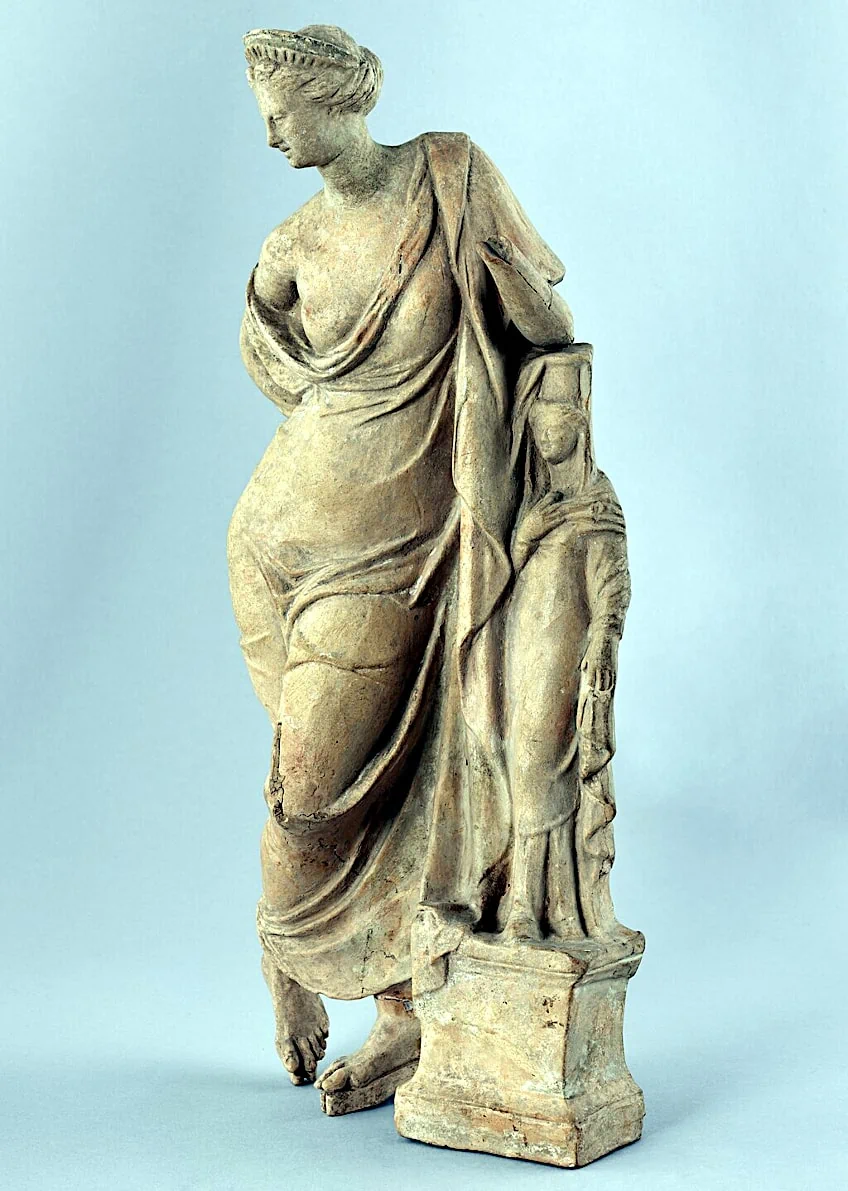 Statuette showing Venus/Aphrodite leaning on a statue of Nemesis (2nd Century BCE); Anonyme, sculpteur, CC0, via Wikimedia Commons
Statuette showing Venus/Aphrodite leaning on a statue of Nemesis (2nd Century BCE); Anonyme, sculpteur, CC0, via Wikimedia Commons
Family and Background
Nemesis has often been described as a child of Nyx (Night) and Erberus (Darkness). She is regarded as the sister of several primordial deities, including Hypnos (Sleep), Thanatos (Death), and Eris (Discord). According to some traditions, Nemesis was also the name of one the Oceanides, but given that there were as many as 41 of these sisters in some accounts, it is to be expected that they would share their names with other deities.
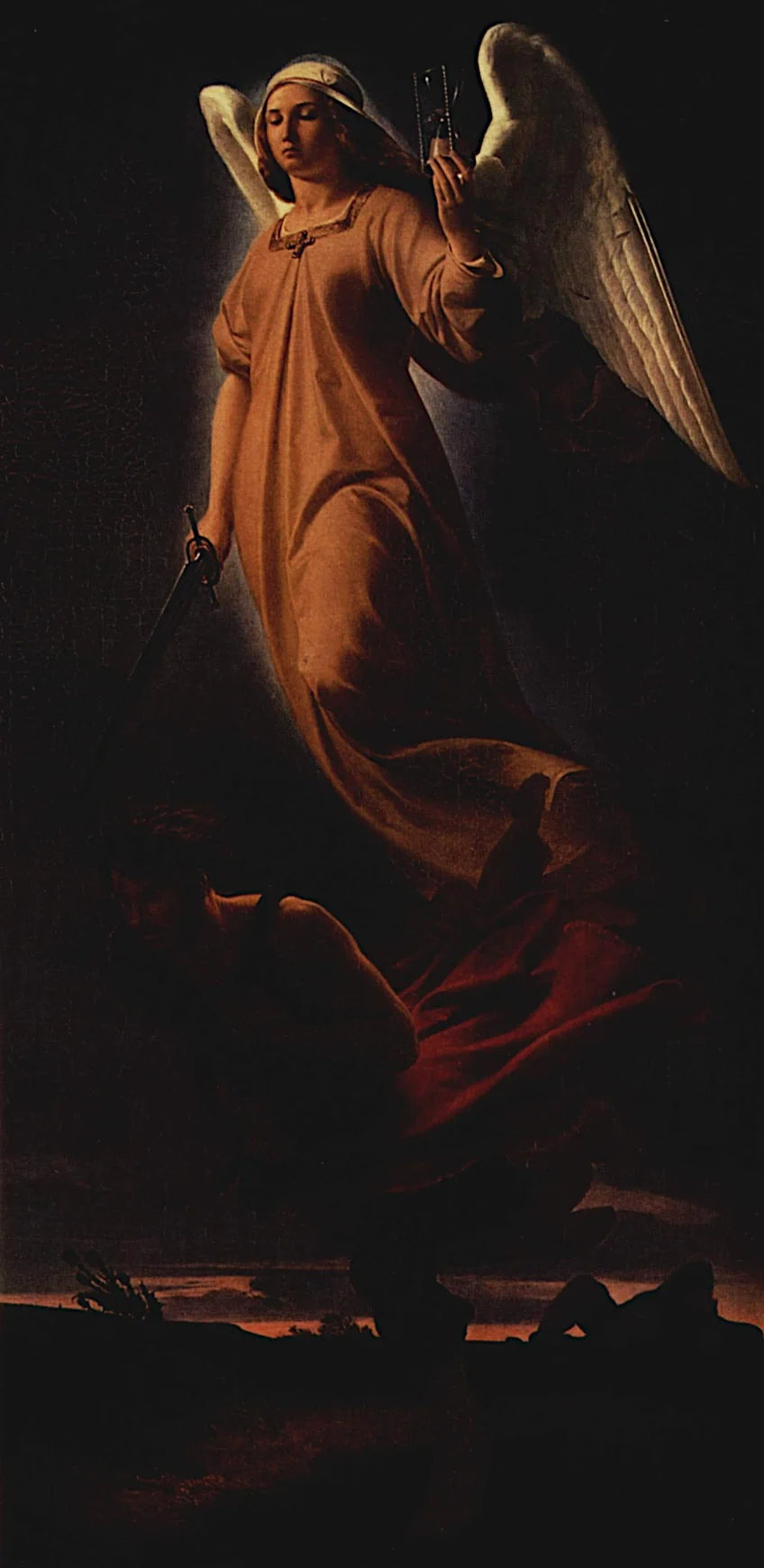 Nemesis by Alfred Rethel (1837); Alfred Rethel, Public domain, via Wikimedia Commons
Nemesis by Alfred Rethel (1837); Alfred Rethel, Public domain, via Wikimedia Commons
Family
In Greek mythology, Nemesis has siblings who are related to various parts of the natural and paranormal world. Hypnos is the deity of sleep and has often been referred to as Nemesis’ brother. He is in charge of both gods and humans’ falling asleep and their subsequent dreams. Thanatos is the embodiment of death and is likewise believed to be Nemesis’ brother and symbolizes a peaceful death. Eris is the deity of discord and disorder. According to a few myths, she is also regarded as Nemesis’ sister.
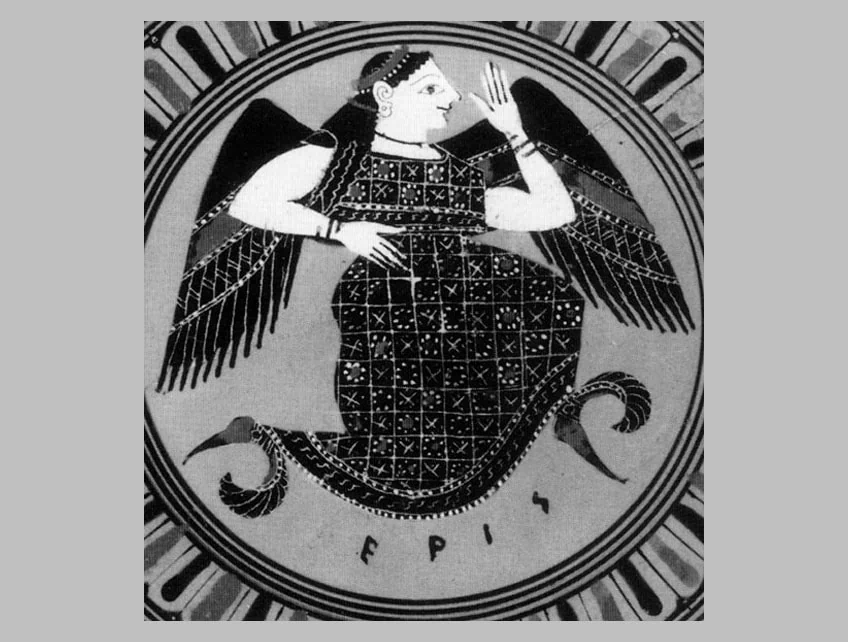 Tondo of a black-figure kylix depicting Eris (575-525 BCE); Altes Museum, Public domain, via Wikimedia Commons
Tondo of a black-figure kylix depicting Eris (575-525 BCE); Altes Museum, Public domain, via Wikimedia Commons
Eris is famous for her role in the events leading up to the Trojan War, in which she caused the “Apple of Discord” to be flung among the goddesses.
Air is personified by Aether, whereas daylight is personified by Hemera. They are occasionally identified as Nemesis’ siblings, however, how they relate varies from one account to another.
Offspring
In some tales, the Greek goddess Nemesis is claimed to have been impregnated by Zeus and given birth to the egg from which the beautiful Helen whose abduction by Paris instigated the Trojan War. In other versions of the myth, Zeus impregnates Leda disguised as a swan who then births the egg from which Helen and some of her siblings hatch.
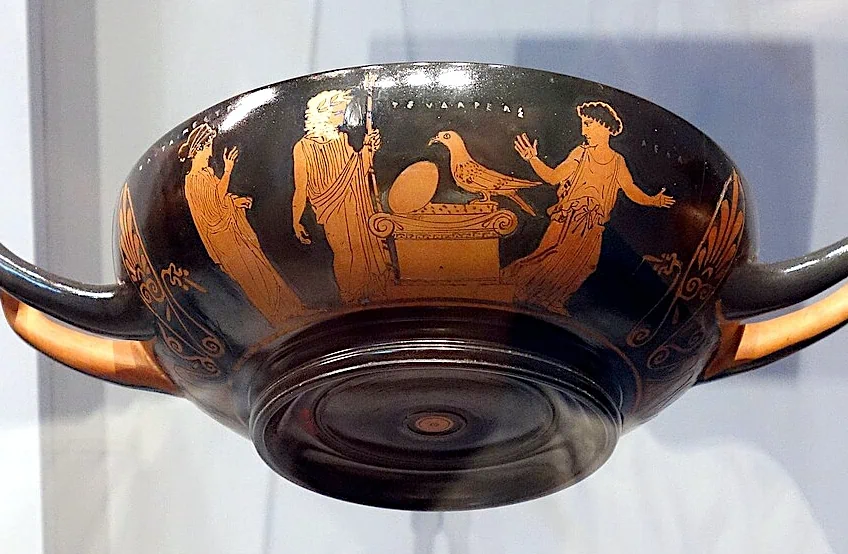 Attic red-figure cup showing the birth of Helen (c. 430-420 BCE); Mark Landon / Wikimedia Commons
Attic red-figure cup showing the birth of Helen (c. 430-420 BCE); Mark Landon / Wikimedia Commons
Helen’s half-sister Clytemnestra has often been connected with Nemesis. She is a well-known in Greek mythology for murdering her husband Agamemnon upon his return from Troy. She killed him in vengeance for sacrificing their daughter Iphigeneia to ensure favorable winds when sailing to Troy at the outset of the war.
In other versions, Nemesis is regarded as the mother of numerous winged animals known as “Nemesis birds”, although the names and information about these animals vary.
The Role of the Goddess of Revenge
Nemesis was the goddess of retribution, who dealt with evildoers, but also made sure that everything in existence was balanced in accordance with the will of Zeus.
It was Nemesis who guaranteed an equal amount of happiness and misery, as well as bad and good luck; When Tyche, the goddess of Fortune, was overly kind, Nemesis would intervene.
Nemesis is especially associated with the notion of fairness and the maintenance of moral order. She makes sure those who demonstrate arrogance or commit acts of injustice face adequate punishment or vengeance. When Themis (Law) was violated, Nemesis would spring into action.
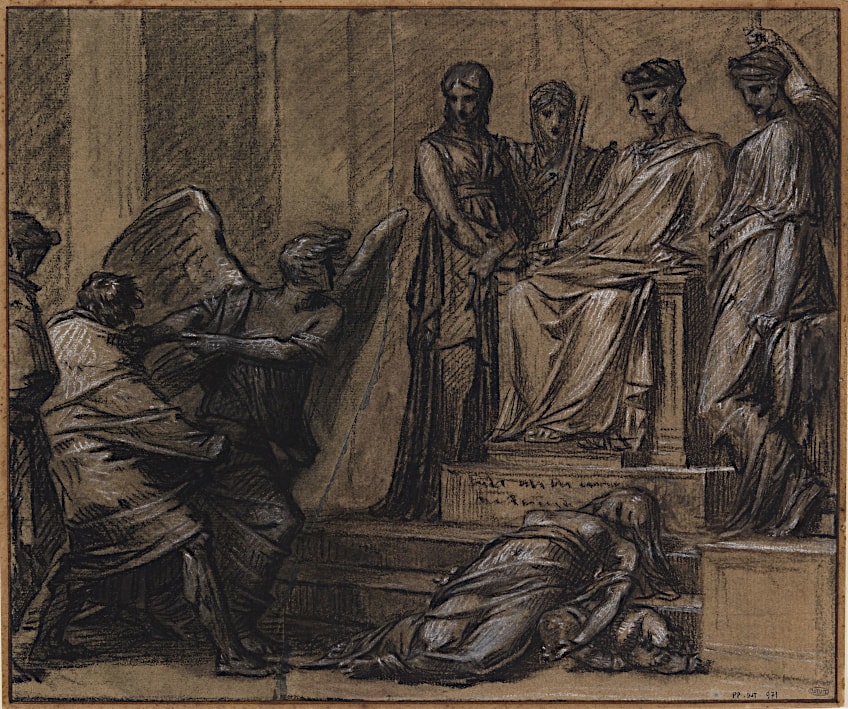 Themis and Nemesis (sketch for Divine Justice Prosecuting Crime) by Pierre-Paul Prud’hon (1805); Prud’hon, Pierre-Paul (Cluny, 04–04–1758 – Paris, 16–02–1823), draughtsman, CC0, via Wikimedia Commons
Themis and Nemesis (sketch for Divine Justice Prosecuting Crime) by Pierre-Paul Prud’hon (1805); Prud’hon, Pierre-Paul (Cluny, 04–04–1758 – Paris, 16–02–1823), draughtsman, CC0, via Wikimedia Commons
Personality and Attributes
Nemesis is well-known for her integrity in administering justice. She never favors any one person or deity over another instead she guarantees that everyone gets what they deserve depending on their behavior. She symbolizes the notion of “just desert” and guarantees that no one avoids the repercussions of their actions.
Nemesis is shown as tenacious and relentless in her quest for justice. She fiercely pursues those who have done wrong and assures that they are held accountable.
She is steadfast in her objective and cannot be misled or appeased. Despite her role in vengeance, Nemesis is frequently shown as calm, collected, and peaceful. She preserves Universal order and balance, offering equilibrium to the natural and moral spheres. She functions as a moderating factor, reducing excessive self-importance or ambition.
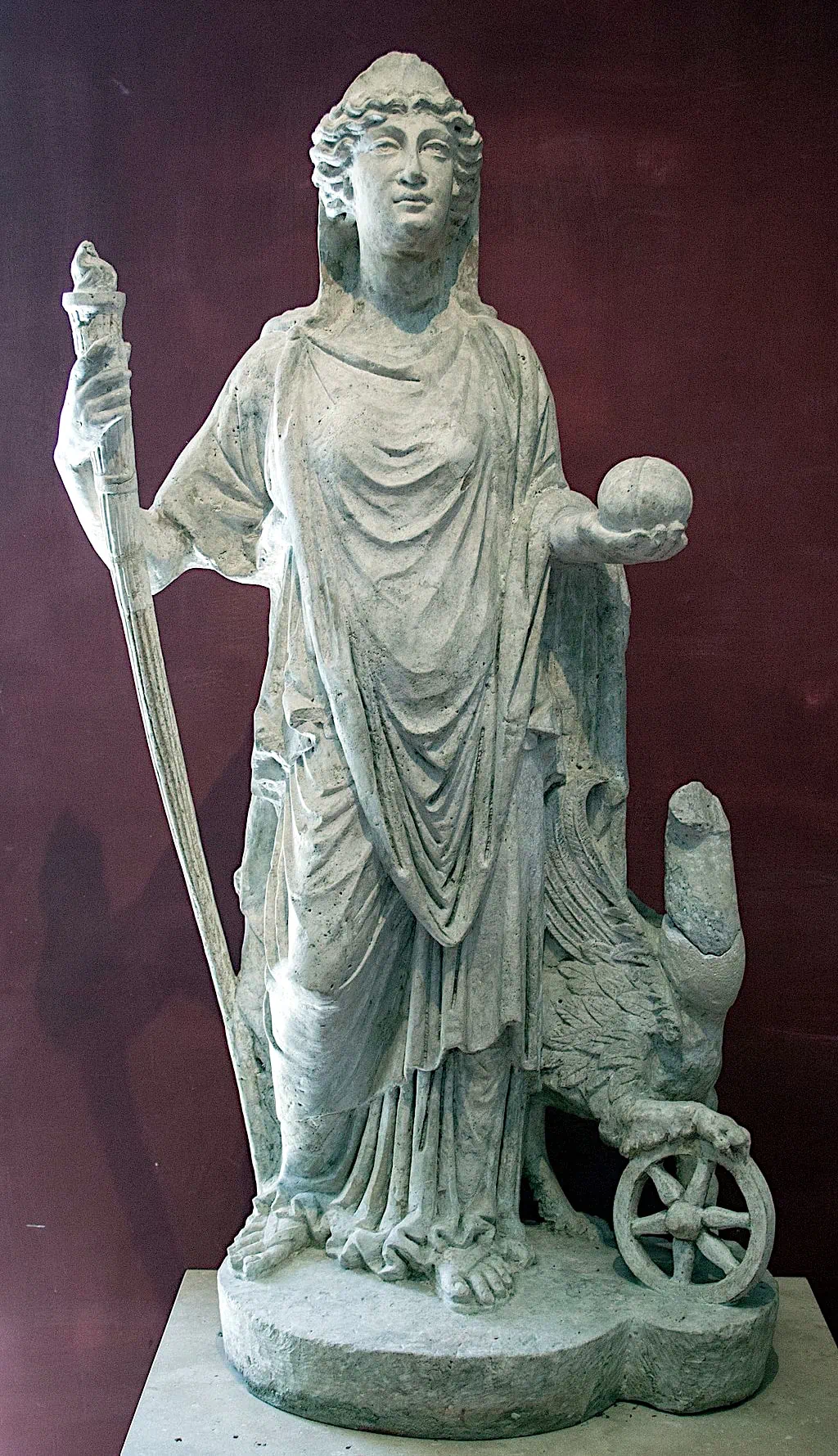 Statue of Fortuna-Nemesis (2nd or 3rd Century CE); See page for author, Public domain, via Wikimedia Commons
Statue of Fortuna-Nemesis (2nd or 3rd Century CE); See page for author, Public domain, via Wikimedia Commons
Physical Appearance
Nemesis is often depicted with wings, indicating her speed and tenacity in exacting vengeance. These wings might be illustrated as feathered, bird-like wings or as mystical, translucent wings. In some portrayals, Nemesis has a veiled or partially hidden visage that highlights her cryptic and elusive nature. This adds to the intrigue and implies that her actual identity may be hidden.
One famous artist who created an engraving portraying Nemesis was Albrecht Dürer.
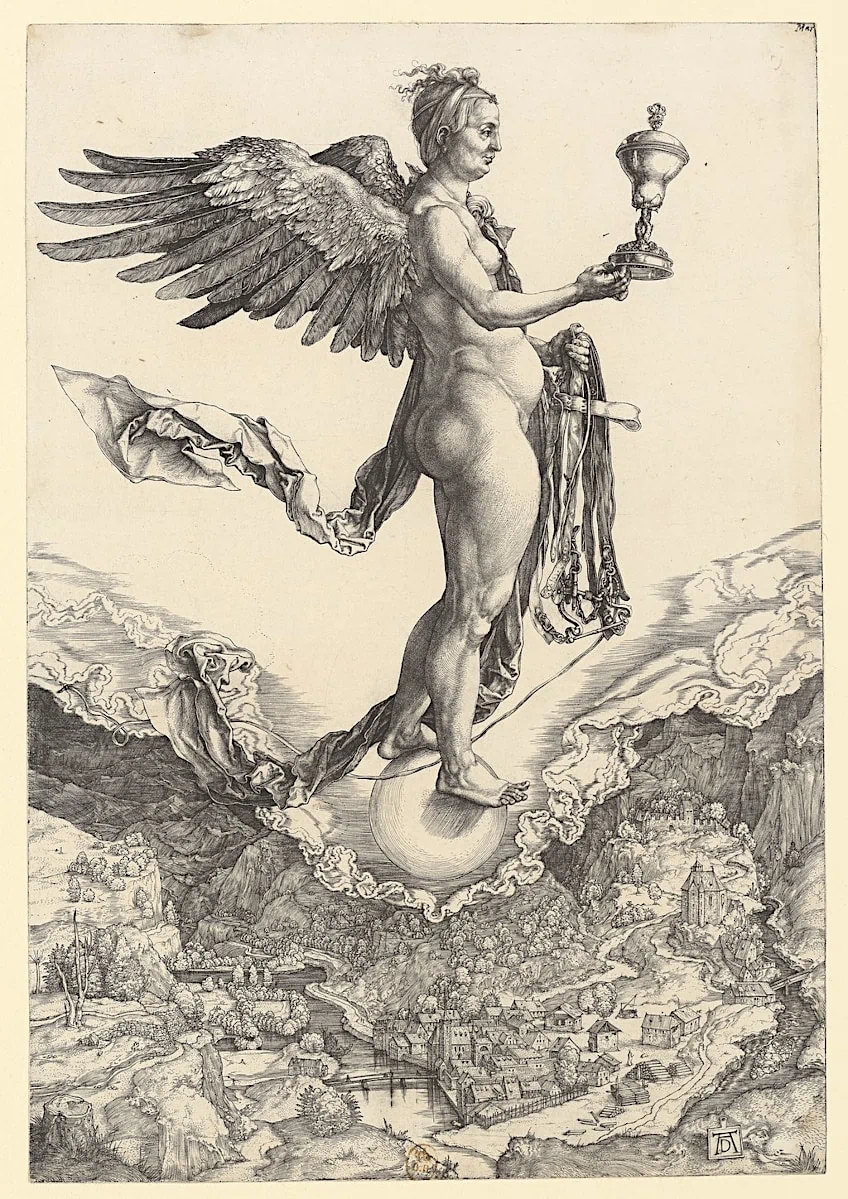 Nemesis by Albrecht Dürer (1501-1502); Albrecht Dürer, Public domain, via Wikimedia Commons
Nemesis by Albrecht Dürer (1501-1502); Albrecht Dürer, Public domain, via Wikimedia Commons
In this image Dürer fuses Nemesis, the Greek goddess of revenge, whose chalice and bridle indicate castigation, with Fortuna, the typical winged figure poised on a globe. The scene underneath the figure has been identified as Chiusa, a South Tyrolean village that Dürer apparently depicted during his first trip to Venice in 1495. Dürer’s landscape combines a panoramic grandeur with an incredible amount of discernible detail.
Nemesis’ Symbols
All of the Greek goddess Nemesis’ symbols are related to her roles as the goddess of retribution and the goddess of revenge. These include the scales, sword, wings, wheel, and veil. In Greek mythology, the scales signify justice and balance. They represent the fair assessment of people’s conduct and the imposition of adequate consequences. The scales convey the concept that justice ought to be impartial and balanced. The sword and whip represent Nemesis’ strength and authority in carrying out divine justice.
When required, the sword indicates her capacity to execute decisive and ruthless retribution. The whip represents the rapid and unrelenting character of her vengeance.
Together, these symbols emphasize Nemesis’ position as an agent of divine retribution, striking down those who behave with arrogance or commit acts of injustice. Wings are connected with speed and movement, symbolizing Nemesis’ capacity to seek people out and administer her vengeance quickly. The wheel symbolizes the cyclical nature of justice and the inevitability of fate. It represents the concept that actions have repercussions that come full circle.
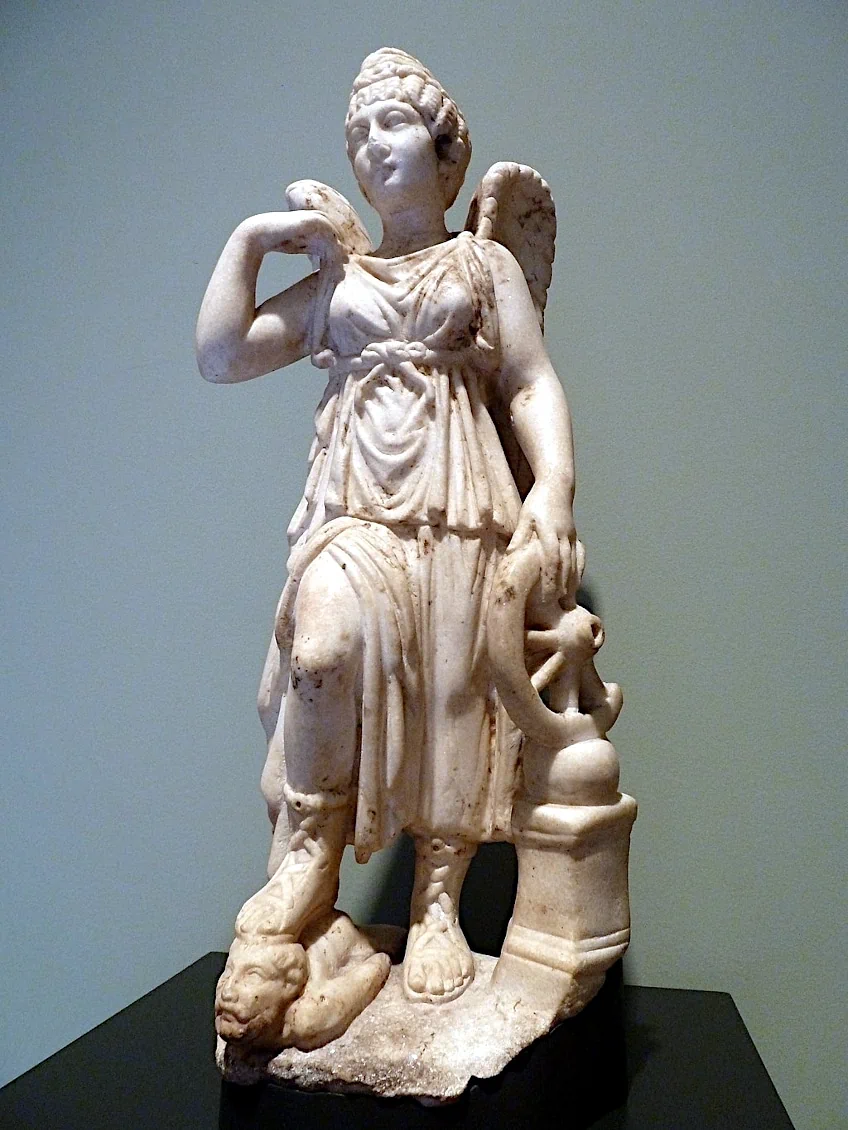 Roman statuette of Nemesis shown holding a wheel and treading on the head of a prone male figure (150 CE); Dave & Margie Hill / Kleerup from Centennial, CO, USA, CC BY-SA 2.0, via Wikimedia Commons
Roman statuette of Nemesis shown holding a wheel and treading on the head of a prone male figure (150 CE); Dave & Margie Hill / Kleerup from Centennial, CO, USA, CC BY-SA 2.0, via Wikimedia Commons
Where Nemesis is veiled, it represents secrecy and concealment. It symbolizes Nemesis’ mysterious personality as well as her ability to work secretly and undetected. The veil implies that her real identity and motives are unknown, adding a feeling of unpredictability to her persona. It emphasizes the idea that divine justice works in subtle and unknown ways, usually, surprising people who assumed they can avoid it.
Nemesis’ Mythology
Nemesis generally exhibited pity and indignant outrage on behalf of someone seeking her advice or assistance. The goddess is generally associated with individual exploits or crimes, although the Greeks believed she was able to punish whole civilizations.
The Greeks even attributed her to their triumph over the Persian armies in the fifth century BCE. Nemesis signified rightful victory and the endurance of justice due to her sympathy for victims and her involvement in correcting political injustices.
Nemesis and Ariadne
The Cretan Princess Ariadne fell in love with the Athenian prince Theseus who had traveled to her father Minos’ kingdom as part of a tribute of fourteen young people who were to be sacrificed to a monster kept in a labyrinth known as the Minotaur. She helped Theseus defeat the Minotaur in exchange for marrying her and taking her back to Athens with him. After they fled, they landed on the island of Naxos where Theseus abandoned Ariadne.
In ancient art, the image of Nemesis waking the sleeping Ariadne to show her Theseus sailing away was a popular topic.
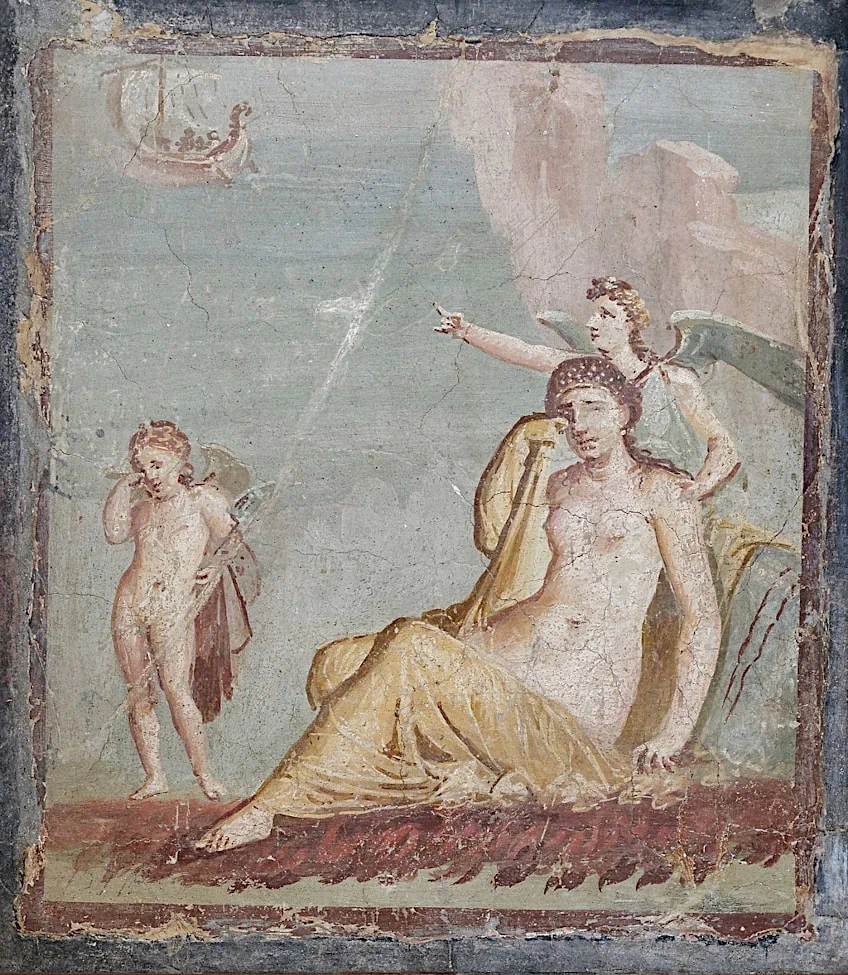 Fresco depicting Ariadne and Eros weeping as Nemesis points at the ship of Theseus as he abandons her (1st Century CE); Naples National Archaeological Museum, Public domain, via Wikimedia Commons
Fresco depicting Ariadne and Eros weeping as Nemesis points at the ship of Theseus as he abandons her (1st Century CE); Naples National Archaeological Museum, Public domain, via Wikimedia Commons
However, Ariadne was not the only one to suffer for her betrayal. Theseus forgot to change the black sails of mourning on his ship to the white sails that would signal the success of his mission. As he sailed into the harbor, his father looked out, and seeing the black sails thought that his son was dead. The king was so distraught that he killed himself.
Nemesis and Narcissus
Narcissus, according to Greek mythology, was a magnificent and boastful hunter who scorned and ignored those who liked him. A nymph called Echo spotted Narcissus one day and fell madly in love with him. Echo, though, could only repeat the words of others and could not initiate discussion. As a consequence, Narcissus turned her down, breaking her heart. When the goddess Nemesis saw Narcissus’ hubris and rejection of Echo, she was determined to teach him a lesson.
Nemesis brought Narcissus to a clean pool of water, where he peered at his own reflection. Narcissus, enamored with his own beauty, fell in love with his own reflection, incapable of looking away from the reflection he saw in the water.
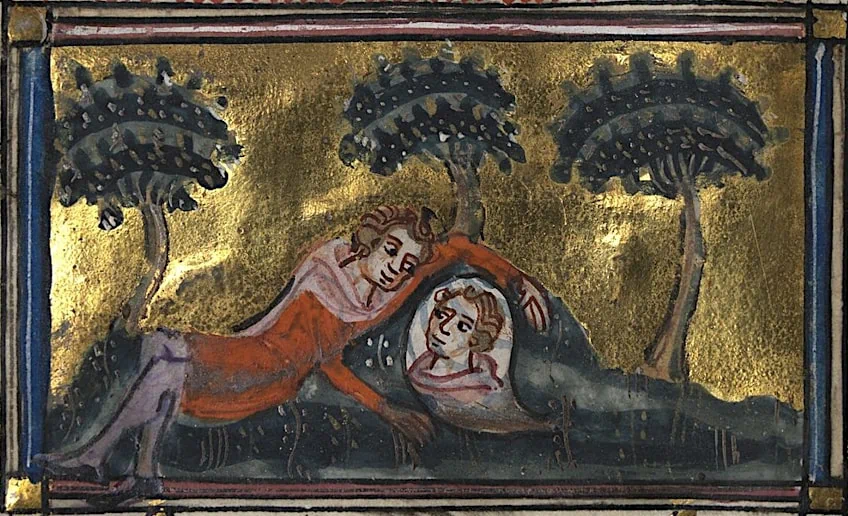 Illuminated manuscript with an illustration of Narcissus (14th Century); National Library of Wales, CC0, via Wikimedia Commons
Illuminated manuscript with an illustration of Narcissus (14th Century); National Library of Wales, CC0, via Wikimedia Commons
Narcissus was unaware that the image he liked was simply a reflection, and he became progressively infatuated with it. He spent days and nights staring at his reflection, incapable of eating or drinking because his love for himself overwhelmed him. In the end, Narcissus recognized he could never have the object of his passion and perished at the pool’s edge. A magnificent daffodil is reputed to have blossomed in his place, signifying vanity.
Narcissus’ narrative serves as a warning about the risks of excessive self-absorption.
Nemesis and Aura
Aura, a beautiful nymph, said that her body was more maidenly and pure than Artemis’s. The Greek goddess Artemis was humiliated by this boast, and she sought vengeance on Aura for her hubris. Artemis sought assistance from Nemesis, the goddess of vengeance, on how she should punish Aura for her arrogance.
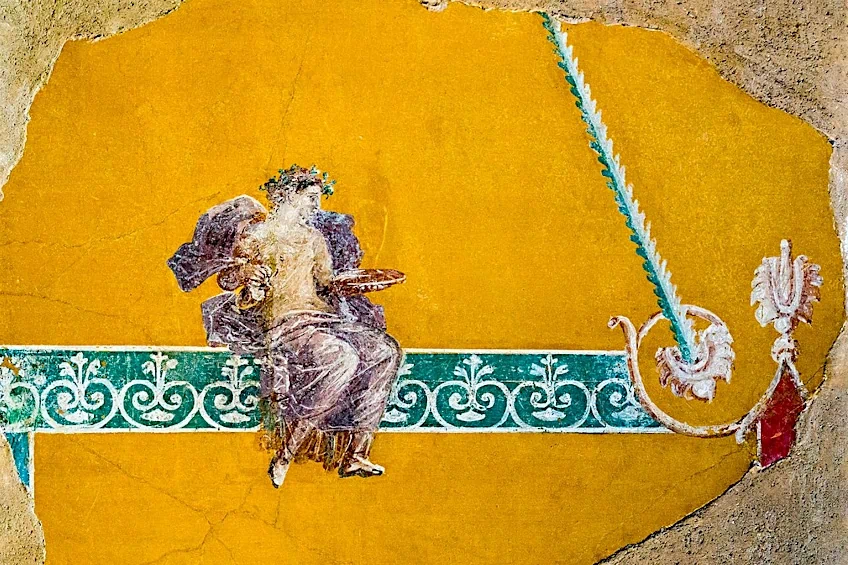 Fresco depicting a nymph (possibly Aura) from Pompeii (c. 20-10 BCE); ArchaiOptix, CC BY-SA 4.0, via Wikimedia Commons
Fresco depicting a nymph (possibly Aura) from Pompeii (c. 20-10 BCE); ArchaiOptix, CC BY-SA 4.0, via Wikimedia Commons
Nemesis suggested that depriving Aura of her virginity was the greatest way to punish her.
Following Nemesis’ advice, Artemis had Dionysus, the god of wine and pleasure, rape Aura, therefore tainting her virginity. The loss of Aura’s innocence was retribution for her arrogant assertion and demonstrated the force of divine justice. It also emphasizes Nemesis’ responsibility in making sure that arrogance is not unpunished.
Nemesis and Agamemnon
Agamemnon, the king of Mycenae and leader of the Greek armies during the Trojan War, made a catastrophic decision. Before sailing to Troy, he slaughtered his daughter Iphigeneia to please the goddess Artemis and secure good winds for the Greek fleet. The gods and human beings alike were outraged and condemned his deed of sacrificing his own offspring.
Agamemnon suffered a succession of catastrophes and obstacles after returning from the battle, but the worst of those awaited him at home.
Agamemnon’s wife Clytemnestra, plotted against him with her lover Aegisthus to avenge the death of her daughter. Agamemnon was stabbed in his bath after arriving back home. When Agamemnon’s son Orestes killed his mother and her lover to avenge his father’s death, Clytemnestra’s ghost asked the Erinyes to avenge this act of matricide. Born from the blood of the castrated Uranus, these goddesses avenged crimes that upend the social order. The Erinyes pursued Orestes endlessly and drove him mad until he found refuge at the temple of Apollo who purified him, thereby releasing him from suffering the divine consequences of his crime.
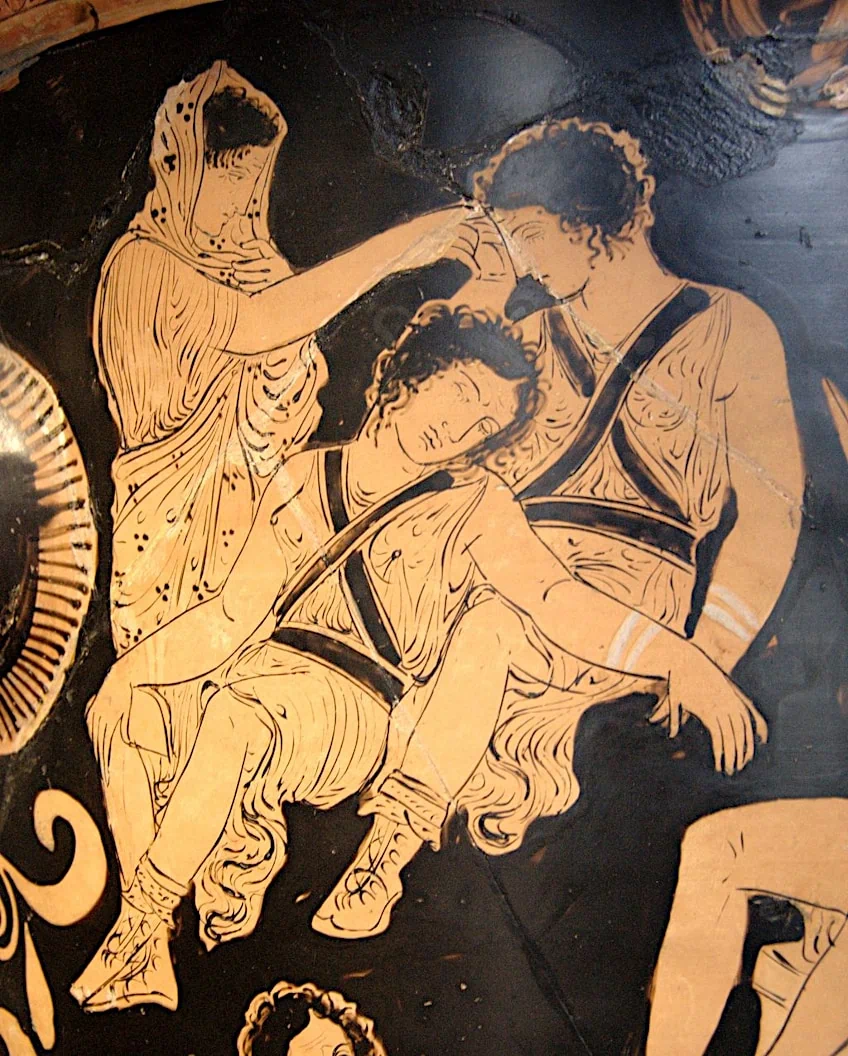 Apulian red-figure bell-krater showing the ghost of Clytemnestra trying to wake the Erinyes to avenge her murder (380-370 BCE); Louvre Museum, Public domain, via Wikimedia Commons
Apulian red-figure bell-krater showing the ghost of Clytemnestra trying to wake the Erinyes to avenge her murder (380-370 BCE); Louvre Museum, Public domain, via Wikimedia Commons
The Worship of Nemesis
The worship of Nemesis seems to have begun among the Ionian Greeks but spread rather widely across the ancient world. One of Nemesis’ most prominent shrines was at Rhamnus in Attica. According to some legends, this is where Zeus seduced Nemesis. After the Persians attacked Athens in the early 5th century BCE, the shrine at Rhamnus was established. Agoracritus of Phidias built the cult statue of Nemesis for this temple, of which a few fragments and later copies still exist.
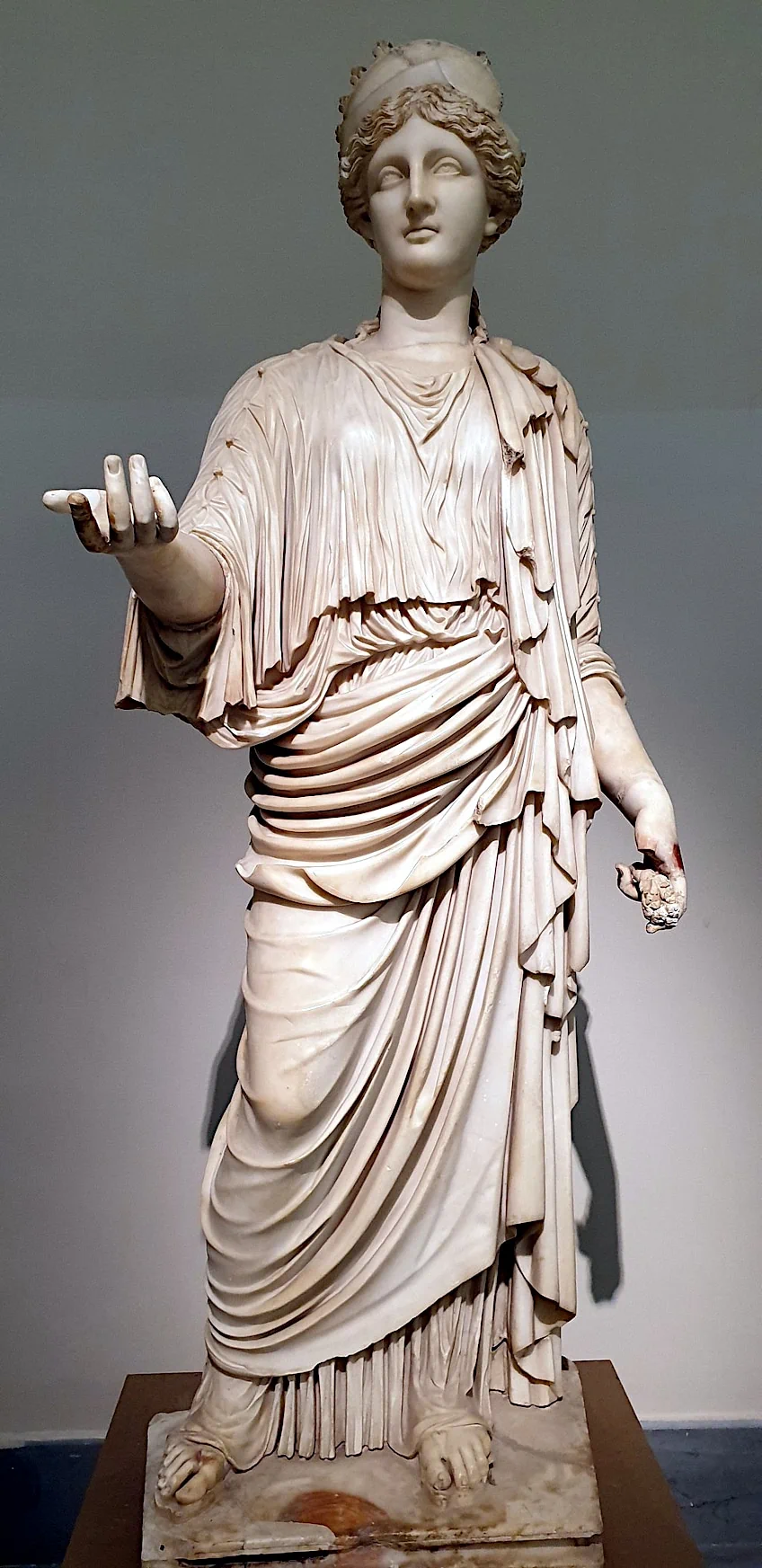 2nd Century CE Roman copy of Agoracritos’ 5th Century BCE cult statue of Nemesis at Rhamnus; Jamie Heath, CC BY-SA 2.0, via Wikimedia Commons
2nd Century CE Roman copy of Agoracritos’ 5th Century BCE cult statue of Nemesis at Rhamnus; Jamie Heath, CC BY-SA 2.0, via Wikimedia Commons
Another prominent Nemesis cult existed at Smyrna, a Greek city on Anatolia’s coast. Nemesis was venerated as a twin being in Smyrna. This duality’s theological explanation is unclear. Maybe the two Nemeses reflected the goddess’s dual forces: one good and kind, the other terrible and ruthless. It was stated in the Peloponnese that the veneration of Nemesis was initially established by the Argive King Adrastus. Because of this, Nemesis was sometimes referred to as “Adrasteia” by some authorities.
While Nemesis was occasionally associated with and revered as Adrasteia, the two deities were also thought to be separate yet nonetheless related.
There are indications of a united cult of Nemesis and Adrasteia on the Greek island of Cos. Other deities were also affiliated with Nemesis. She, for instance, may have been venerated with Themis at Rhamnus, and there was a sculpture of Nemesis in a temple dedicated to Apollo, Leto, and Artemis at Cirrha near Delphi. Nemesis worship quickly expanded beyond the Greek realm. Nemesis served as one of the tutelary goddesses of the arena at Rome, and there was even a monument of her on Capitoline Hill in the center of the city. The Romans appear to have identified Nemesis primarily with imperial authority and its ability to deliver justice and punishment.
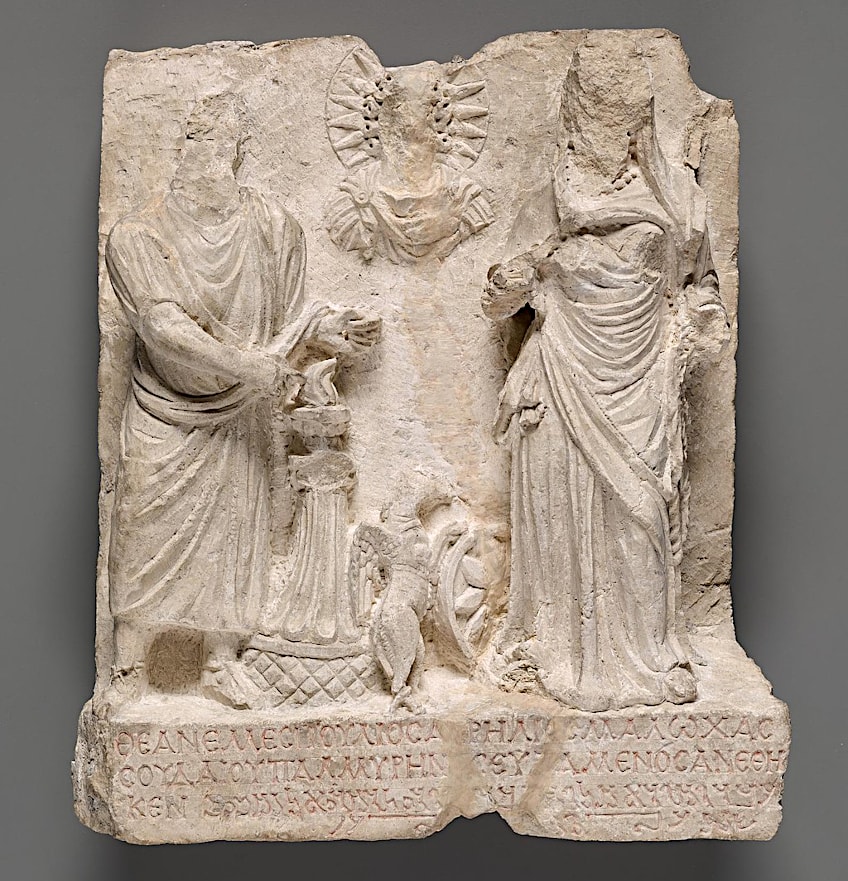 Votive plaque dedicated to Nemesis showing a worshiper on the left standing next to an altar (244 CE); Yale University Art Gallery, Public domain, via Wikimedia Commons
Votive plaque dedicated to Nemesis showing a worshiper on the left standing next to an altar (244 CE); Yale University Art Gallery, Public domain, via Wikimedia Commons
Other Nemesis temples may be found across the Greco-Roman world, including Cyzicus in northern Anatolia and Patrae in the northeastern Peloponnese.
Festivals in Honor of the Goddess of Vengeance
There were not many festivals that were solely dedicated to the Greek goddess Nemesis in Greek mythology. Yet, there were various rituals and festivals centered around balance, retribution, and justice, where she was honored and called upon. In Rhamnus, a city located in Attica, there was a festival celebrated called the Nemeseia, which took place in the sacred precinct of the goddess of retribution. Here various rituals and offerings that were performed in honor of the Greek goddess Nemesis.
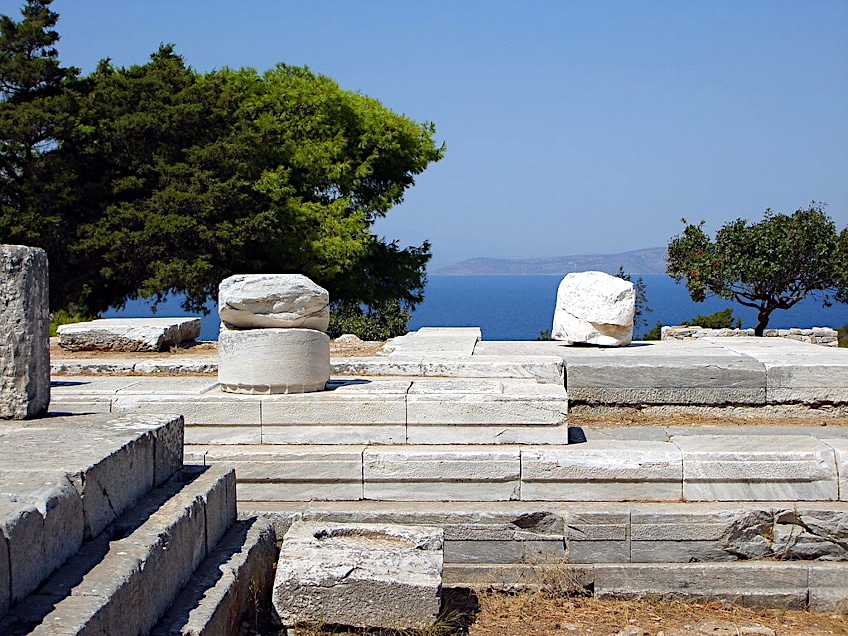 Remains of the temple of Nemesis at Rhamnus; Karta24, CC BY-SA 3.0, via Wikimedia Commons
Remains of the temple of Nemesis at Rhamnus; Karta24, CC BY-SA 3.0, via Wikimedia Commons
The Greek goddess Nemesis was also occasionally invoked at the Panathenaic Games, a renowned cultural and athletic festival that took place in honor of the Greek goddess Athena. Various religious ceremonies, processions, and athletic competitions would take place here.
At events such as this one, Nemesis would often be called upon to make sure that the competitions were fair and that those who tried to cheat were punished for their actions.
Nemesis Through the Ages
Nemesis was associated with the goddess Invidia, who personified jealousy and envy in Roman culture. This link highlighted her role in punishing individuals who displayed excessive pride or harmed others. Worship and reverence of Nemesis, as well as other Greek gods and goddesses, eventually declined with the development of Christianity and the fall of old polytheistic faiths. Christian theology promoted forgiveness and charity above punishment, shifting the emphasis away from Nemesis-related themes.
Nemesis continued appearing in literary works and artistic depictions throughout the following eras, spanning the Medieval and Renaissance eras where Nemesis served more as a metaphorical or allegorical concept.
 Nemesis by Paolo Veronese (1560-1561). In this allegorical image located between imagery depicting Prudence and Strength/Power, the bridle and measuring rod – both attributes of Nemesis – are held by a male figure with a female figure under his control, suggesting a balance of these opposites; Paolo Veronese, Public domain, via Wikimedia Commons
Nemesis by Paolo Veronese (1560-1561). In this allegorical image located between imagery depicting Prudence and Strength/Power, the bridle and measuring rod – both attributes of Nemesis – are held by a male figure with a female figure under his control, suggesting a balance of these opposites; Paolo Veronese, Public domain, via Wikimedia Commons
Nemesis was depicted as a figure of retribution or divine justice, appearing in songs, plays, and artworks as a cautionary tale against pride and arrogance. Nemesis has lost most of her religious or cultic importance in the modern day. Her mythological figure and ideas, on the other hand, have impacted popular culture. Nowadays, the name of the Greek goddess Nemesis is most usually used to refer to an archenemy. Nemesis sometimes appears as a powerful Greek goddess in contemporary interpretations of Greek mythology.
Nemesis is a minor supporting character in the animated film Hercules, wherein she is the executioner of the deities and the first love of Hercules.
The Concept of Hubris in Ancient Greece
If you were in ancient Greece, you didn’t want to be accused of hubris. Hubris derives from the word hybris which in antiquity described the humiliation or degradation of someone by inflicting violence upon them. The philosopher Artistotle defined hubris as when those who are overly arrogant and proud, humiliate others for the sake of personal pleasure.
Poets such as Hesiod defined hubris as ignoring cosmic boundaries to act against the divine order, while in Greek tragedy hubris underlies the “tragic flaw” which sends characters to their doom.
Any display of hubris made you a target for the Greek goddess Nemesis, and as we now know, she is unstoppable. Furthermore, Nemesis and the retribution she spread served as a unifying element throughout the most famous Greek dramas. Odysseus’ boasting after blinding the Cyclops Polyphemus earned him the wrath of Poseidon. Odysseus’ return home was greatly delayed as a result of his arrogance, losing him his crew, his ship, and almost his wife.
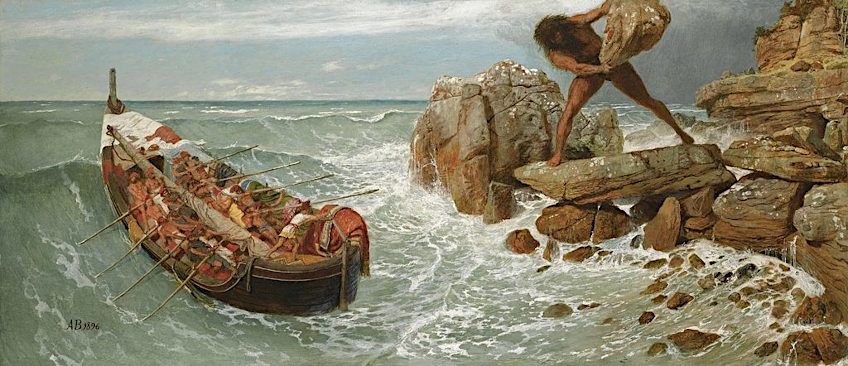 Odysseus and Polyphemus by Arnold Böcklin (1896); Arnold Böcklin, Public domain, via Wikimedia Commons
Odysseus and Polyphemus by Arnold Böcklin (1896); Arnold Böcklin, Public domain, via Wikimedia Commons
The impact of Nemesis spreads deeper into literary works such as tragedies and onto the theater. Nemesis, albeit less personified in drama, nonetheless plays an important function. Only Nemesis can make someone accountable for their acts and make them face the repercussions of their behavior. In Greek mythology, Nemesis’ role was to be a steadfast protector of the natural order of all things. Her attitude was heavy-handed, but she tried to strike a balance in terms of her effect on human affairs.
The gods define the nature of things and to act against them is to threaten the balance of the entire world.
The Lessons of Nemesis’ Mythology
The mythology surrounding Nemesis imparts various ethical principles that are widespread in Greek society. Nemesis acts as a reminder that extreme hubris, conceit, and contempt for the gods or people can have disastrous effects. Those who behave with arrogance frequently face punishment or payback for their actions. Nemesis signifies divine justice and the preservation of global equilibrium. She guarantees that no one goes over the appropriate boundaries and that acts have proper repercussions. This demonstrates the significance of fairness, responsibility, and faith in a higher power. Nemesis’ stories instill the importance of modesty and moderation.
Finding a balanced approach while avoiding extremes can help a person avoid Nemesis’ notorious wrath.
She also stands for the idea that fate and fortune can both be unpredictable. A person’s actions and decisions can have an impact on the results and consequences they confront. It serves as a reminder that even the most powerful people are vulnerable to the whims of fate. Nemesis’s mythology pushes people to behave ethically and with fairness and consideration towards others. It underscores the concept that choices have repercussions and that people must accept responsibility for their actions.
The Legacy of Nemesis
Nemesis has come to represent vengeance and divine justice. Her role in punishing those who display arrogance or commit crimes has had a long-lasting influence on the notion of accountability and equality in many countries. Nemesis has helped shape intellectual and ethical debates. The concepts of balance, justice, and nemesis – representing the vengeance or downfall that results from inordinate pride – have all affected moral and ethical debate.
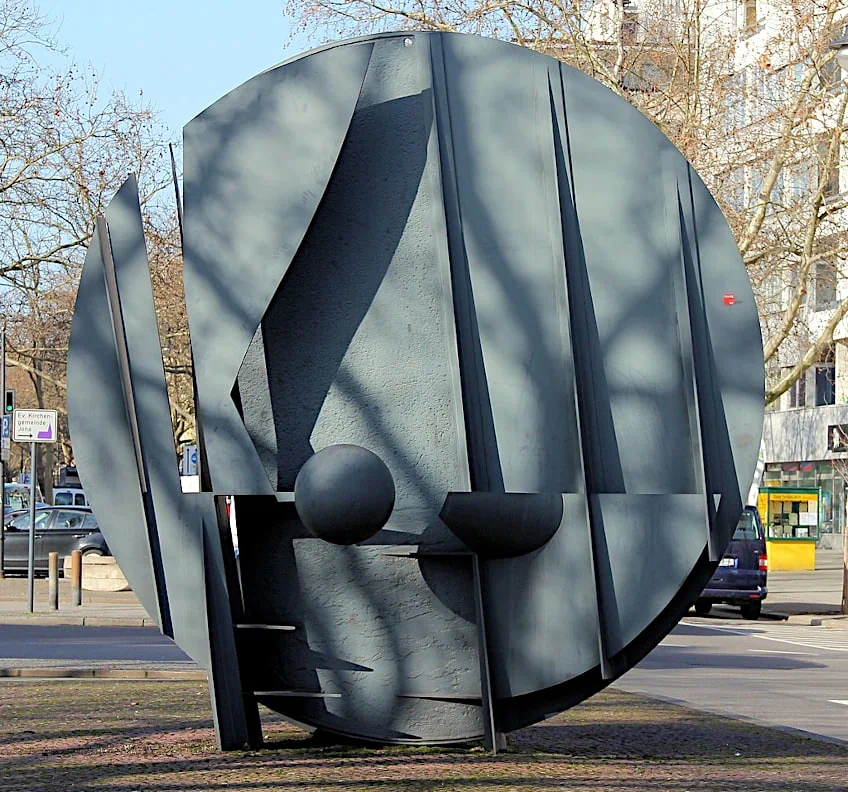 Eye of Nemesis by Bernhard Heiliger (1979-80); OTFW, Berlin, CC BY-SA 3.0, via Wikimedia Commons
Eye of Nemesis by Bernhard Heiliger (1979-80); OTFW, Berlin, CC BY-SA 3.0, via Wikimedia Commons
The term “nemesis” has entered the English language and is frequently used to denote a fierce opponent or a person’s demise as a result of their own actions.
It is related to the concept of fair retribution or the repercussions of arrogance. The legends and symbols linked with Nemesis remain cultural metaphors. They remind people of the repercussions of their actions, the need for humility, and the necessity to steer clear of overconfidence or arrogance.
That completes today’s look at the goddess of retribution, Nemesis. This powerful deity ensured that every person took responsibility for their actions by having to face her wrath when they did something wrong. She was said to be the child of Nyx, the famed goddess of the night. She was often portrayed with wings, which represented her ability to swoop down on wrongdoers when necessary. She was also often portrayed with her scales, which represent the balance and equilibrium that she embodied. Even though the Greek goddess Nemesis metered out the karma of people’s actions, she was not generally regarded as an evil entity, but rather one that helped to maintain the balance in the cosmos. If someone had undeservedly attained too much good fortune or wealth, it was her job to tip the scales back into equilibrium.
Frequently Asked Questions
What Is Nemesis the God of in Greek Mythology?
Nemesis was an ancient goddess of divine vengeance. As such, she punished wicked conduct and unearned good fortune. Her Roman equivalent was Invidia, the goddess of retribution and envy. Sources generally identified Nyx, the goddess of the night, as Nemesis’ mother, but differed on her father. Nemesis’ father has been identified as Oceanus, Zeus, and Erebus, while some texts state she has no father at all. Erebus (Darkness), Nyx’s regular consort, is occasionally stated as Nemesis’ father. According to Hesiod’s interpretation of the gods’ genealogy, Nemesis is an early goddess of a generation preceding Zeus and the Olympians. As a judge, Nemesis was frequently represented with scales and a sword, although she could also be seen with a measuring rod, whip, bridle, dagger, scourge, wings, or a chariot drawn by a griffin.
Who Were the Greek Goddess Nemesis’ Children?
When it comes to Nemesis’ children, sources were likewise contradictory. Some accounts stated Helen of Troy and her twin sister, Clytemnestra, were raised by Leda but Nemesis was their mother. Depending on different versions of their myth, Castor and Pollux, the semi-divine twins, were either the sons of Leda or of Nemesis.
What Are the Greek Goddess Nemesis’ Symbols?
Being a deity associated with justice and balance, the scales are a significant symbol of this goddess. The sword is also significant as it symbolizes her sharp and quick decision-making capabilities, which she uses to impart justice to those who have done wrong. She is able to pursue those who have done wrong very fast due to her wings, which she uses to swoop down on the unsuspecting individuals who had somehow managed to anger the gods, or by being called upon by the people who had been victimized. In Greek mythology, these symbols together highlight the concepts of balance, justice, and authority, and the repercussions of one’s deeds.

I am deeply passionate about history and am constantly fascinated by the rich and complex stories of the past. As the editor-in-chief of learning-history.com, I have the opportunity to share this passion with a wide audience through the creation and distribution of engaging and informative content about historical events, persons, and cultures. Whether it’s through writing articles and blog posts or creating videos or podcasts, I strive to bring the past to life in a way that is both accurate and enjoyable. My expertise in history, combined with my strong writing and communication skills, allows me to effectively communicate complex historical concepts and make them accessible and interesting to a wide range of readers. I am truly grateful for the opportunity to share my love of history with others through my work on learning-history.com.

